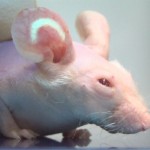Implantable Devices
Long-term in vivo glucose monitoring using fluorescent hydrogel fibers

The use of fluorescence-based sensors holds great promise for continuous glucose monitoring (CGM) in vivo, allowing wireless transdermal transmission and long-lasting functionality in vivo. The ability to monitor glucose concentrations in vivo over the long term enables the sensors to be implanted and replaced less often, thereby bringing CGM closer to practical implementation. However, the full potential of long-term in vivo glucose monitoring has yet to be realized because current fluorescence-based sensors cannot remain at an implantation site and respond to blood glucose concentrations over an extended period. Here, we present a long-term in vivo glucose monitoring method using glucose-responsive fluorescent hydrogel fibers. We fabricated glucose-responsive fluorescent hydrogels in a fibrous structure because this structure enables the sensors to remain at the implantation site for a long period. Moreover, these fibers allow easy control of the amount of fluorescent sensors implanted, simply by cutting the fibers to the desired length, and facilitate sensor removal from the implantation site after use. We found that the polyethylene glycol (PEG)-bonded polyacrylamide (PAM) hydrogel fibers reduced inflammation compared with PAM hydrogel fibers, transdermally glowed, and continuously
responded to blood glucose concentration changes for up to 140 days, showing their potential application for long-term in vivo continuous glucose monitoring.
Injectable hydrogel microbeads for fluorescencebased in vivo continuous glucose monitoring
Fluorescent microbeads hold great promise for in vivo continuous glucose monitoring with wireless transdermal transmission and long-lasting activity. The full potential of fluorescent microbeads has yet to be realized due to insufficient intensity for transdermal transmission and material toxicity. This paper illustrates the highlysensitive, biostable, long-lasting, and injectable fluorescent microbeads for in vivo continuous glucose monitoring. We synthesized a fluorescent monomer composed of glucose-recognition sites, a fluorogenic site, spacers, and polymerization sites. The spacers are designed to be long and hydrophilic for increasing opportunities to bind glucose molecules; consequently, the fluorescent monomers enable high-intensive responsiveness to glucose. We then fabricated injectable-sized fluorescent polyacrylamide hydrogel beads with high uniformity and high throughput.Wefound that our fluorescent beads provide sufficient intensity to transdermally monitor glucose concentrations in vivo. The fluorescence intensity successfully traced the blood glucose concentration fluctuation, indicating our method has potential uses in highly-sensitive and minimally
invasive continuous blood glucose monitoring.
